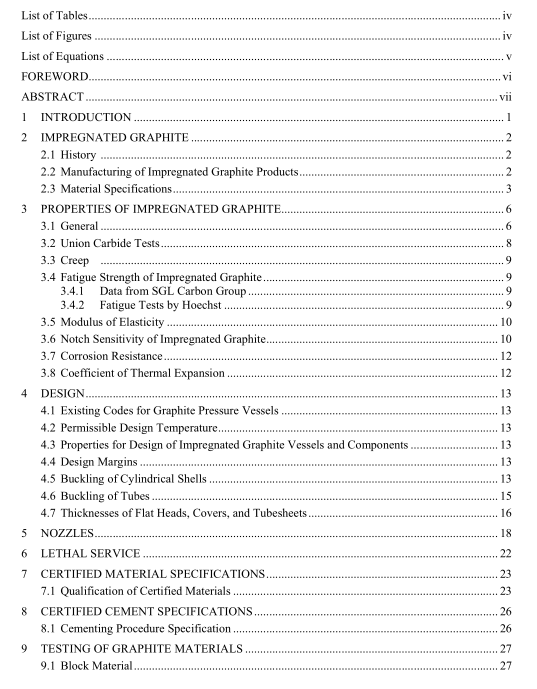ASME STP-PT-004:2005 pdf download IMPREGNATED GRAPHITE FOR PRESSURE VESSELS
2 IMPREGNATED GRAPHITE2.1 History
Graphite is a naturally occurring form of carbon. Edward G. Acheson accidentally synthesizedgraphite while he was performing high-temperature experiments on silicon-carbide.At about 4,150C(7,500°F) he found that the silicon in the silicon-carbide vaporized,leaving the carbon behind ingraphitic form. A patent for the manufacture of graphite was granted to Acheson in 1896,andcommercial production started in 18971.
Graphite has been used in the chemical and metallurgical industries since the time of Sir HumphreyDavy; circa 1800.However, porosity (on the order of 25%) prevented the use of graphite in manychemical process applications. In the 1930s, the then National Carbon Company developed a process(impregnation) to make the graphite impervious to fluids. The imperviousniess is obtained by fillingthe pores of the graphite material with thermosetting resins,such as phenolics,furans and epoxies,during a vacuum/pressure impregnation process.
Today,major elements of process equipment are manufactured from impregnated graphite. Theseelements include tubes,nozzles and cylinders,solid blocks,plates,tubesheets,and more. Theimpregnation process has allowed graphite with its excellent corrosion resistance and thermalconductivity properties to be used in chemical process equipment under pressure, such as imperviousgraphite shell and tube heat exchangers (see Figure 1). Typical applications include condensing andevaporating acids, such as hydrochloric and phosphoric.Over the past 60 years,improvements in theimpregnation process allowed shell and tube heat exchangers to increase in size from 7-tube units 9 ftlong to 2,125 tube units 27 ft long.
2.2Manufacturing of Impregnated Graphite Products
The materials used in manufacturing graphite are fillers (petroleum coke,natural and syntheticgraphite) binders (coal tar pitch), and additives. Their conversion into machined impervious graphitematerial for process equipment involves the following steps:
.Prepare the raw materials by grinding, sorting and blending..Mix the raw materials to form a molding flour.
Compress the molding flour into tubes and blocks.
Bake the formed components at temperatures of about 1,800°F (980°C).Baking the shaped
components (to carbonize the binder) produces a porous solid material whose pore structurechanges only very slightly in the graphitizing process.
Graphitizing is carried out in graphitizing furnaces at 4,700 to 5,400F (2,595 to 2,980°C). Thisprocess rearranges the carbon-rich raw materials and carbonized binders at a molecular level intographite. The resulting material exhibits high thermal shock resistance and conductivity, as wellas strong resistance to chemical attack.
.Graphite is machined with standard machine tools into process equipment components, such as
heat exchanger tubes, heat exchanger blocks, tube sheets, and headers.
• The impermeability of graphite is achieved by impregnating the graphite components with resin. The resin is forced into the pores by a vacuum/pressure process and subsequently cured at a predetermined temperature. This also provides a significant increase in strength.
• The bonding of joints in graphite components is termed cementing. The cement typically consists of a corrosion resistant resin binder, graphite powder, and a catalyst. Stresses at the cemented joint are minimized by using an appropriate joint design. The cementing operation is monitored and controlled by the manufacturer. A typical flow diagram for the manufacture of impregnated graphite products is shown in Figure 2.
2.3 Material Specifications Specifications exist for graphite and for impregnating agents; however, there are no published specifications for impregnated graphite. Impregnated graphite is made up of different combinations of graphite and impregnating agents that are combined in a specified process to make the composite material. Also, some grades may be more suitable for certain applications (service conditions) than other grades. The graphite manufacturing process is specified by the manufacturer and is proprietary. The “specified process” is a listing of each step required to produce a specific “grade” of impregnated graphite. It includes such items as the grade of graphite, resin, vacuum, pressure, and any other steps needed to produce the desired grade of impregnated graphite.ASME STP-PT-004:2005 pdf download
ASME STP-PT-004:2005 pdf download
